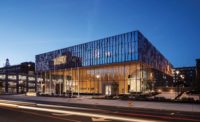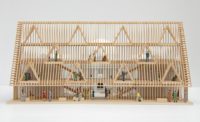The Wild Beast at CalArts














Architects & Firms
Valencia, California
Designing a small performing arts building that would work for both indoor recitals and outdoor concerts, Craig Hodgetts and Hsinming Fung drew inspiration from musical instruments. “We wanted a building in which performance and shape are inextricably linked,” explains Hodgetts, who trained as a musician before studying automotive design and then architecture. “So we looked at violins and guitars and how they work.”
Such explorations informed the architects’ strategy for the Wild Beast, a 3,400-square-foot facility at the California Institute of the Arts (CalArts) in Valencia, California.
The project’s name pairs it in a kind of artistic bestiary with CalArts’ downtown Los Angeles venue known as REDCAT (Roy and Edna Disney/CalArts Theater) in Frank Gehry’s Disney Concert Hall complex about 30 miles away. It stems from a quote, etched on one of its glass panels, by avant-garde composer Morton Feldman, who said, “I am interested in how the wild beast lives in the jungle, not in the zoo.” Visitors to the school can read the project’s name and its energetic form as retorts to the heavy, brick-and-concrete architecture of the Valencia campus’s enormous main building. Light on its feet and curvaceous in elevation, the Wild Beast serves as an agile counterpoint to the rectilinear mass of its much larger neighbor.
Hodgetts+Fung was a logical choice for the job, having developed a reputation for performing arts projects (such as the renovation of the Hollywood Bowl) and temporary structures (especially Towell Library at UCLA, an aluminum-and-fabric-roofed building used for two-and-a-half years in the late 1990s while the school’s permanent library received a seismic upgrade). Hodgetts also brought a bit of history with him, having served as a founding associate dean of CalArts’ short-lived School of Design in the early 1970s. Although the Wild Beast was conceived as a permanent facility, the client and architects wanted it to “have the feeling of something temporary,” says Fung. So the initial designs envisioned a tentlike fabric structure. But noise from a nearby highway and an adjacent parking lot made such a strategy untenable.
Instead, the architects developed a lightweight monocoque roof that cantilevers 60 feet and curves in two directions. A large 30-by-16-by-3-foot block of concrete anchors the structure on the east and is buried out of sight. Hodgetts and Fung kept the roof profile as thin as possible (just 8 inches), rested it on a curved steel beam, and wrapped it around half-inch-thick frameless glass so the building appears to be all shell and no support.
A pair of 23-by-16-foot fiber-cement doors slides open for outdoor performances when roughly 800 people can sit on the adjacent lawn and in the amphitheater. When the doors are closed, the building serves as a small recital and rehearsal space accommodating about 140 people on folding chairs. Making the building work for both modes was a big challenge, especially since its axis rotates 90 degrees when switching from one configuration to another. Alternating between a long narrow volume and a shell open to the outdoors “drove the acoustician crazy,” admits Hodgetts.
The solution was to design the building as a piece of kinetic architecture in which MDF panels on the north side of the space move and clerestory windows on the south elevation pivot out to redirect and adjust the sound. Water-jet-cut aluminum “spiders” hold the glass panels in place, while an actuator (typically used on airplanes to control wing flaps) moves them in or out. Hodgetts and Fung love to adapt elements from other industries in their projects; here they took recycled wood drums used in printing and employed them as curved, fixed-in-place panels dispersing sound in the Wild Beast’s interior. “What we learned from our work on the Hollywood Bowl was to establish an absorptive shell, then line it with reflective surfaces,” explains Fung. To light the space, the architects recessed standard fluorescent tubes within the curved wood panels.
Since the building sits below a spacious parking lot, the architects needed to provide a long, universally accessible ramp, which they refer to as “the tail of the beast.” A small masonry building on the northeast portion of the site houses restrooms and was added after the performance pavilion was completed.
Of the building’s form, Hodgetts says, “We were trying to find the right gesture, one that could handle a polyfunctional space and work with a tricky site.” He and Fung weren’t thinking of anything zoomorphic, he states, and the name of the project came much later than the design. Talking about the building’s curvy east elevation, Fung forgoes any animal references in favor of one with a Hollywood provenance. “I think of it as the building’s Jayne Mansfield moment,” she laughs.
Working with a tight budget ($2.35 million), the architects didn’t get everything they wanted. For example, they lost the battle to install radiant heating and cooling instead of a forced-air system. And masonry block ended up on the north facade, creating a less graceful elevation. But the building’s fluid geometry and excellent acoustics strike the right notes overall.
Completion Date: August 2009
Gross square footage: 2450 sq. ft.
Total construction cost: $2.35 million
PeopleOwner: California Institute of the Arts
Architect
Personnel in architect's firm who should receive special credit: Architect of record: Hodgetts+Fung
Engineer(s) Civil: KPFF Electrical: Lucci and Associates Mechanical: Design Build
Consultant(s) Lighting: H+F Acoustical: David Conant / McKay Conant Hoover General contractor: HWI / Hinerfeld-Ward Incorporated Photographer(s): Tom Bonner Renderer(s): H+F |
Products
Structural system List type, e.g. concrete or steel frame, wood, etc.: Manufacturer of any structural components unique to this project:
Exterior cladding Metal/glass curtain wall: Custom fabrication Curtain wall: Custom Other cladding unique to this project: Fiber Cement Sheet / Hardy Board |













